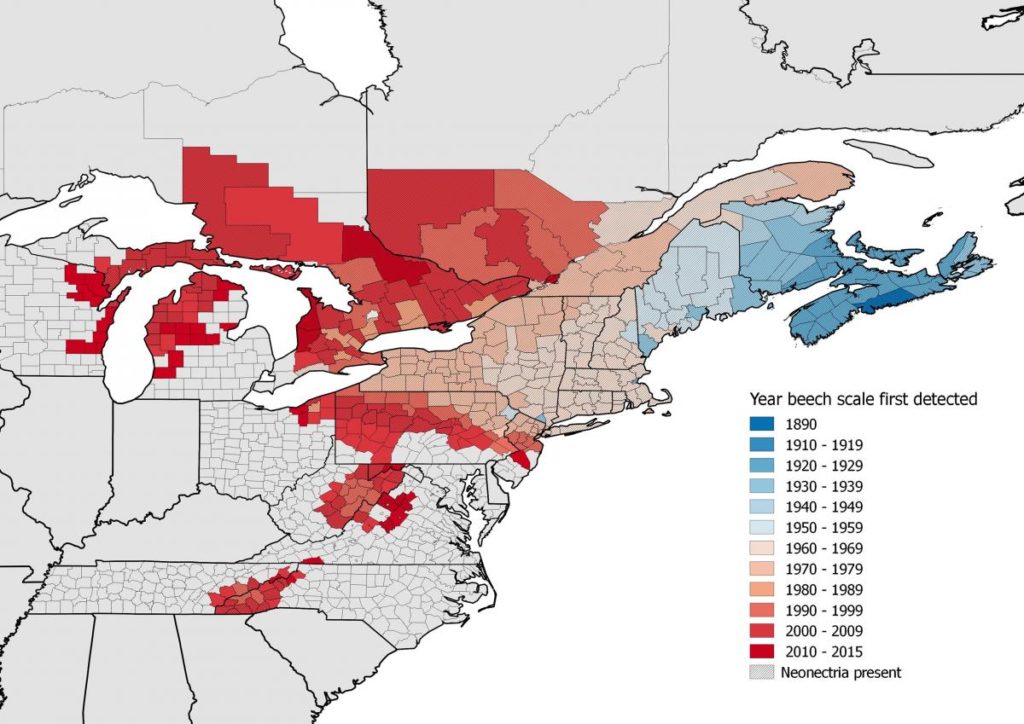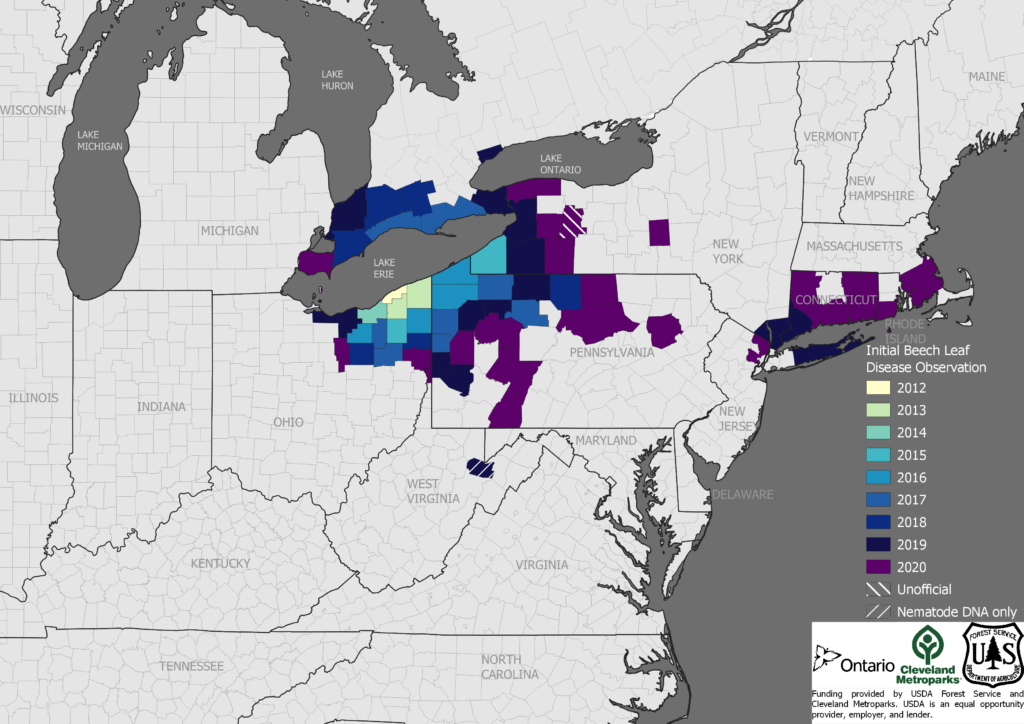
I recently participated in the 2021 annual meeting of the Northeast Forest Pest Council (virtual, of course). Speakers – most of them from state forestry agencies, but including students – presented a disturbing picture. Numerous established insects and diseases continue to spread. In some cases, they are resurging after weather-caused slow-downs. There are also a few bright spots.
The Alarming
To me the most alarming situation is that for American beech – because all three threats continue to expand.
Beech bark disease Since 2000, BBD has spread across southern Quebec into Ontario, Michigan, and Wisconsin; the Blue Ridge in Virginia; and central New Jersey.
Beech leaf disease Originally discovered near Cleveland in 2012, BLD has been spreading, primarily eastward.

BLD was detected for the first time in Massachusetts, in Plymouth and Bristol counties (on the coast North of Cape Cod). It might also be in Worcester. Both American and European beech trees of all sizes are affected; some of the largest are “on the verge” of death. (Felicia Hubacz)
The first detections in New Jersey are in Bergen and Essex counties – bordering southern New York. Both detections were by members of the public. Rosa Yoo says there is confusion about which state agency has the lead, so no official notices have been published (although the detection is recorded on the map). She hopes to establish long-term monitoring plots.
West Virginia now says that BLD is present in Tomlinson Run State Park in Hancock County. Kristen Carrington plans to focus detection efforts on the state’s norther panhandle which rises along the Pennsylvania border. She has established seven long-term monitoring plots.
Meanwhile, states where BLD was detected earlier continue to add new counties to the list of those infested. In New York, five new counties have been recorded. All the New York State finds have been on public lands, so the map doesn’t present the full picture (Carlson). In Connecticut, the disease is in all coastal counties and is more scattered in inland areas. Connecticut has set up some long-term monitoring plots. (Stafford)
New York is also trying to identify insect species associated with beech trees and beech litter – as a first step in trying to determine whether any vector the nematode that is thought to cause the disease. I suggest that it is also useful to understand which arthropod species might be at risk as beech decline. Don’t folks often lament the lack of this information for chestnut? Aren’t scientists praised for compiling initial lists for insects associated with ash?
Beech leaf mining weevil According to Jeff Ogden of the Nova Scotia Department of Lands and Forestry, this weevil has defoliated trees on 5987 hectares. First detected near Halifax in 2012, the weevil is now found throughout Nova Scotia. Some trees near Halifax have died. Ogden believes the weevil could be spread on movement of logs with bark and leaf litter. Camping is very popular in Nova Scotia, so the firewood risk appears real.
Also alarming is the resurgence of hemlock woolly adelgid across the region. HWA had been suppressed for a few years by harsh winters, but that reprieve is over. HWA is in 52 of 55 West Virginia counties (Kristen Carrington). Newly detected outbreaks are found across Pennsylvania and in the Adirondacks of New York. HWA continues to spread north – slowly – in New Hampshire and Vermont. In Nova Scotia, the outbreak detected in 2018 is spreading slowly to the West (Jeff Ogden).
All states are releasing a variety of biocontrol agents, often Laricobius nigrinus but also L. osakensis. Various agents have been released for decades — for example, Connecticut has released more than 125,000 agents over more than 20 years. I do hope the two Laricobius beetles prove to be more effective in controlling the agelgid.
Several states note that elongate hemlock scale (Fiorinia externa) is now at least as damaging as the adelgid.
Pennsylvania is growing hemlocks for restoration purposes; New Jersey has begun a similar program. See my earlier blog about efforts to breed hemlocks resistant to the adelgid, available here.
Spotted lanternfly is now established in nine states — from Ohio and West Virginia to Connecticut. It continues to spread. In the longer-established infestation areas of southeastern Pennsylvania, black walnut has been severely damaged by early instar larvae. In New Jersey, eight counties are under quarantine, but the insect has been detected much more broadly. The newest state is Connecticut, which found populations in several counties and is drafting quarantine regulations. Massachusetts, Maine, and Vermont have found some egg masses or evidence of infestation on goods entering from Pennsylvania, but not yet an established population.
The Not So Alarming — but Still Concerning
Asian Longhorned Beetle Massachusetts is consistently finding fewer trees infested by the ALB. In 2020, they found only one! It was isolated in the middle of a golf course. Intensive surveys and trapping in the vicinity found no other infested tree.
This is great news! However, I worry that resources will be withdrawn too soon – especially with APHIS’ need to fund an eradication program for the same pest in a swampy forest area in South Carolina where it will be difficult to work. Already Massachusetts reported that it has fewer traps and staff, and some difficulties accessing the lure.
Early Detection Efforts
New Jersey and West Virginia have carried out surveys of sassafras stands for the redbay ambrosia beetle (also here). West Virginia is also surveying for Phytophthora ramorum (the sudden oak death pathogen) and walnut twig beetle (vector of thousand cankers disease). Funding for surveys of the former probably came from USFS Forest Health Protection; for the latter, from APHIS. I applaud these “early detection” efforts.
Too Late for “Early Detection” but Getting Welcome the Attention
New Hampshire noted rising concern about Jumping worms. The state has received 48 complaints since 2017; 43 of these were in 2020. This led to a spirited discussion about invasive worms’ impacts. Don Eggen noted that concern focuses on soils in unglaciated regions. Non-native worms can destroy the duff layer. Most of the research has been carried out in the Midwest. See my earlier blogs about invasive earthworms here.
Tim Tomon reported that the USFS Morgantown WV research office has sampled the Allegheny NF. They have found other invasive earthworms but not jumping worms. Rosa Yoo of New Jersey alerted participants to the jumping worm research and management group – JWORM
Other Updates
Beech leaf disease
The USDA Forest Service has published a Pest Alert on BLD. Google it now. When a url becomes available I will update this notice. The flyer includes contact information for a site that provides both detection training and a place to record your finds.
Sudden Oak Death
The EU1 strain was detected in forest trees in Del Norte County, California in autumn 2020. This detection was both the first officially confirmed detection of P. ramorum in Del Norte County and the first detection of the EU1 strain in forest trees in California. The source is unclear. The nearest infestation is 12 miles away, along the Winchuk River in Curry County, OR; those trees are infected with the NA1 strain. The nearest known EU1 infestation is about 35 miles away. The site of the California EU1 infestation has minimal California bay laurel (Umbellularia californica). This detection has led to designation of Del Norte County as officially infested; it becomes the 16th California county so designated. [Information from the California Oak Mortality Task Force newsletter for December 2020, available here.]
Posted by Faith Campbell
We welcome comments that supplement or correct factual information, suggest new approaches, or promote thoughtful consideration. We post comments that disagree with us — but not those we judge to be not civil or inflammatory.
For a detailed discussion of the policies and practices that have allowed these pests to enter and spread – and that do not promote effective restoration strategies – review the Fading Forests report at http://treeimprovement.utk.edu/FadingForests.htm